As of early 2014 I’m looking around for work and have been “freelancing” for three years. Most of my career has consisted of working with print, editing, writing, proofreading, and mechanicals and layout. After thirty years in the business, and fifteen writing and researching Forgotten New York (which will likely continue until death or incapacitation) as an inveterate nostalgist, I decided to take a look back and see where I’ve been. All eighteen of the buildings in which I have worked for money are still standing, though the streetscapes surrounding them are very different in some cases.
BTW, if anyone would like to use me or knows where I may be useful, drop a line in Comments.
Municipal Photo Studio, Chanin Building, 105 Court Street at Schermerhorn, 5/78–9/78
When discussing these jobs, I’ll limit things to buildings where I worked for two days or more. I’ll keep my comments mainly about the buildings, and briefly talk about the type of work done; in cases where I have interior photos, I’ll include those as well. I have been fortunate enough to work for some big names, which also have iconic buildings associated with their names.
The first paying job I ever had was in a passport photo studio on the ground floor of Brooklyn’s Chanin Building, not to be confused with the much larger, 56-story skyscraper on Lexington Avenue near Grand Central Terminal. I did simple tasks here, such as developing photos in a darkroom and sweeping floors. The money, as with my next job, went toward helping with college tuition and lunch. The studio occupied the space where the nails joint is now.
The row of buildings across Court Street were completely razed in the 1990s to make way for a rather ugly entertainment complex including a movie theater and a Barnes & Noble bookstore, so the view I had exiting and entering is completely different from what it was in 1978.
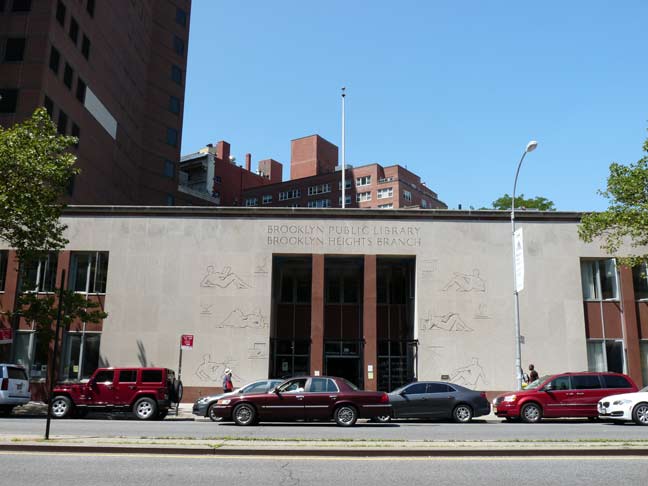
Brooklyn Business Library, in BPL Brooklyn Heights Branch, 280 Cadman Plaza West, 9/78–2/81
According to the NY Public Library website, the Brooklyn Business Library “has a reference collection of more than 100,000 volumes, a circulating collection of 30,000 books, internet access, electronic resources, 800 magazines and newspapers, and real estate data. The Business Library provides industry and demographic data, investment information, business directories and free electronic resources available remotely with library card, as well as access to the internet computers. It also houses the Small Business Information Center, which includes sample business plans, books on starting and advancing a business, and free counseling with SCORE, the Service Corps of Retired Executives.” Amazingly, though, in the summer of 2014 its hours, and that of the Brooklyn Heights Branch, were from 8AM to 1PM Monday to Friday, just 5 hours a day, and there was no air conditioning.
A controversial plan calls for this building to close and the space sold to a developer to build a large residential tower, with the Business and Career Library, as it has been called since 2011, to move to a smaller space at the Central branch at Grand Army Plaza.
My tasks here consisted of shelving books and magazines, labeling with magic marker on book spines (I’m a pretty good hand printer) filing microfiche (books and magazine content was stored in reduced size on flat sheets of glassine that was accessed through a magnifying viewer). Our schedules were posted weekly and I had various hours depending on when my classes at St. Francis College were. I could work a few hours early in the morning and then return for an evening shift, sometimes the same day; the library was open from 8AM to 10PM some days.
While working at BBL, one of their reference volumes was a battered 4-volume 1929 desk atlas of Brooklyn by Belcher-Hyde. Even after I left BBL, I would sometimes come in and ask to see it. My collector friend Brian Merlis had a more pristine copy, but I was happy to see it online a few years ago at Historic Map Works.
Lexigraphics, 150 5th Avenue near Madison Square, 2/81–11/81
I didn’t realize it at the time, since the ground floor had been corrupted and “modernized” while I was working there, but 150 5th Avenue at West 20th Street is perhaps the most architecturally arresting building where I have worked. The Romanesque Revival masterpiece was designed by architect Edward H. Kendall and constructed from 1888-1890 for the Methodist Book Concern and Missionary Society. At the time, this stretch of 5th Avenue was filled with religious publishing companies, and it would continue to harbor publishing for over a century.
The Methodist Book Concern turned out religious tomes and periodicals such as The Christian Advocate and Sunday School Journal. After a few decades, the MBC moved to Nashville, TN in 1939, but maintained a retail office at 150 5th until 1962. The three top floors had been added in 1909, providing medieval-style battlements and the trigram MBC. The building later was home to a laundry workers’ union health center and Ideax, a camera manufacturer. The original ground floor designs had been replaced with a boxier look by the time I arrived in early 1981 at a surviving printing firm, Lexigraphics. Thankfully, a 2001 reconstruction restored them.
Daytonian in Manhattan has more information.
I remember little of Lexigraphics, except that the work was mostly textbooks. We read from proofs on shiny paper or on Diablo-style holed paper. Irv R., the owner, was a kindly sort and one day, during a heat wave, he showed up with a chocolate ice cream bar for everyone. It was a fairly small office.
Photogenic Graphics, 116 West 32nd Street (The Cuyler Building), 1/82–3/82
Again, I was completely unaware of it at the time, but 116 West 32nd, between 6th and 7th avenues, now fascinates me because it features an Art Deco pedestrian bridge high above West 32nd that connects it to what is now the Manhattan Mall. Through much of the 20th Century the Manhattan Mall was owned by the now-defunct megastore Gimbels. In 1926, Gimbels acquired office space in the Cuyler Building and commissioned the walkway to connect the offices with the main store.
Gimbels closed in 1987 and the walkway has gone almost completely unused, but the Bowery Boys were able to acquire some pictures from within the bridge in the spring of 2014. Ironically, there is also a defunct walkway underground, known as the Gimbels Passageway, that runs from Penn Station to Herald Square. It was closed in the 1980s when criminals and homeless took up residence.
Again, I do not recall much from my short tenure except that this was my first experience working late nights, from evenings until early mornings. I was dismissed after three months, but told to call the manager at Photo-Lettering, where I spent the next six years.
The thing about the print business is that some employees hang on for 40 years in some cases, but you can also be bounced very easily if the manager takes a dislike to how you go about your day, or the shine on your shoes. It’s a volatile line of work.

Photo-Lettering, 216 East 45th Street (between 2nd and 3rd Avenues), Kips Bay, 3/82–5/88
I had had a love of type before working at Photo-Lettering, but working at the city’s #1 type shop and primary source for advertising type took things to another level. Just about all my time at the venerable institution, founded in 1936 by Harold Horman and Ed Rondthaler, was spent overnights. For example, the latest I ever left one night was 1 PM — after about 19 hours of work.
I’ve already done an homage to Photo-Lettering in 2009, where I explain the typesetting process it pioneered, so I won’t do too much more here, but I had a blast working at what was one of the world capitals of type — thousands of fonts were on sale and some of the giants in the business such as Ed Benguiat worked there. PL’s clients were the premier ad firms of its day such as J. Walter Thompson, Ogilvy and Mather, Doyle Dane Bernbach and many others still in business or defunct.Type for ads was prepared overnights so it could be delivered to the ad companies early the following day.
Photo-Lettering also gave rise to the Electrographic Corporation and the greatest printing trade magazine, U&lc, a must for type buffs everywhere. I still have Photo-Lettering sample books, as well as Ed Rondthaler’s bio, Life With Letters. Well after retirement and ringing up the century mark, Ed found a new career as a TV pitchman, appearing in commercials for Pearle eye care, among others.
Setting type now consists of pressing a few buttons, but back then, crews of servicepeople “specked” type by measuring the space where the ad copy would appear, and then using gauges to estimate the point size and leading of the type to be set to fill it.

At that point the specked copy would be sent to the typographers, who set the type on computer terminals that employed lengthy sets of code to specify size, leading (the space between lines of type), italics, etc. The practice was similar to html code today, though much different coding was used. Here, my teammates Jose A. and Ed S. sit by one of the terminals.

Then the proofs, on shiny paper, would be sent in to the proofreaders, a staff of three including me. This was my station, the only time I’ve ever had a slanted desk to work from. I used a variety of stamps to mark whether a job was good or needed work, as well as type gauges. If it was ready to release, it would go back to the art department where it was stripped up on a mechanical. In a practice unique to Photo-Lettering as far as I knew, the final proof was on a see-through glassine that made it a lot easier for the mechanicals guy to place it properly.
I left in May 1988 as I wanted more responsibilities management wasn’t willing to provide, and I also wanted to go somewhere with daytime hours. In those days, jobseeking was much different, and slanted more toward the jobseeker — you could dial a number in the newspaper and get an interview the same week. There were also agencies that handled nothing but print jobs. I consulted the Al Smith agency on 42nd Street and talked to the leonine Al Smith himself, who flipped through a Rolodex with a variety of phone numbers. I quickly had a new job…
ANY Phototype, 130 West 29th Street, Penn Station area, 6/88–11/91
Both Photo-Lettering and ANY Phototype were situated in relatively nondescript brick office towers built on NYC’s side streets in the 1910s and 1920s; they mostly displaced thousands of walk-up tenement buildings. 130 West 29th has nice touches like metallic numbers over the door and a green marble foyer.
Note the string of painted ads up the side of the building. During my time here, they were fully visible, as the hotel next door was then a parking lot. Most of these style ads in the West 20s and 30s advertised wholesale clothing firms in what was then a much larger Garment District.
ANY, named for the initials of its three co-owners, was a multilanguage type shop run by Russian immigrants, and did a lot of work in Cyrillic as well as languages using the Roman alphabet. I was called upon to read, character by character, proofs set in French, Italian, German and many other languages including Romansch, which is spoken in Switzerland. Russian speakers typeset and read the material in Russian. Regular periodicals were also produced here, including Circus, which in this era wrote about nothing but pop metal of the Guns ‘N Roses and Poison ilk. ANY is still in business at a different location, though Photo-Lettering closed in the 1990s, selling off its vast library of type.
Line & Tone, 246 West 38th Street, Garment District, 1/92–3/92
I remember little about this shop, except that I was back on overnights. I was actually recruited to work here by one of the managers, Saul B., who likely knew I had been with Photo-Lettering for six years. But, it didn’t last.
Center for the Media Arts, 226 West 26th Street, Chelsea, 5/91–5/93

During the fall of 1990 I made a very good decision to attend a trade school, the Center for the Media Arts. Classes lasted from September 1990 to early 1992; I took classes in design sketching for advertising, video graphics, type (which I did quite well in) and most importantly, computers and computer graphics. I did not own a computer when I entered CMA and wouldn’t own one until 1994, but this school set the groundwork for my employment over the next 20 years, as I spent hours in the computer lab, even on weekends, teaching myself programs such as QuarkXPress, Illustrator and Photoshop on the school’s collection of Macintoshes.

In May 1991 I was asked by the division director if I would like to join the staff as a typesetter on the evening shift. I readily accepted, as the school continued to work with “photo-lettering” type even as desktop publishing was in its nascent stages. I was on the evening shift a few nights a week until the school was forced to shut down in early 1993 after running out of funds; a merger with Mercy College didn’t work out. Above is pictured my small office.
You’ll note that some of my dates overlap. I worked some jobs in the evening while continuing with daytime jobs; I have always preferred to have two jobs whenever I can get them. When they take one away, you still have the other.
ModKomp, 545 Greenwich Street, West Village, 4/92-6/92
This was once of the more rough-and-ready environments I’ve worked in. ModKomp was an old-school type of place and I entered via a loading dock; the shop itself looked like a typesetting and printing museum and contained machinery from a different, prehistoric age. Owner Henry K was a mensch, however, and when I was hired for my next job, he gave me a lift out to Port Washington to look at at apartment (it was a rec room in a basement; I didn’t take it).
I did enjoy working in the far west Village, and walked from the train from Bay Ridge through the Village and also, on my lunch hour, roved Tribeca on my lunch hour, laying the groundwork for Forgotten NY. This and the new computer knowledge I had acquired were putting the FNY pieces in place, though I did not realize it at the time.

Publishers Clearing House, 382 Channel Drive, Port Washington, NY, 7/92–11/99 and 2/06–3/11
Harold Mertz founded Publishers Clearing House in his basement in Sands Point, NY in 1953 as a magazine subscription service. It was a major success almost immediately and grew exponentially, acquiring an office building on Main Street in Port Washington in the early 1960s and later, building a campus at the end of Channel Drive in what was originally a sand pit in 1967. The company, which since added general merchandise to its offerings, began its famous sweepstakes in 1967 and has outlasted all its competitors, though some still think that Ed McMahon of the now-defunct American Family Publishers worked for PCH.

I arrived here by waking up on the subway one Sunday and, finding a Newsday on the bench beside me, opened it to the classifieds and dialed the number PCH placed in an ad for proofreaders. A few weeks later, I was hired. This was probably my most rewarding work experience, since I was permitted to work in a number of departments. When the studio heard I had studied QuarkXPress, Photoshop and Illustrator, I was recruited to work there; and after writing several pieces for the company newsletter (above) I was then asked to move over to copywriting.
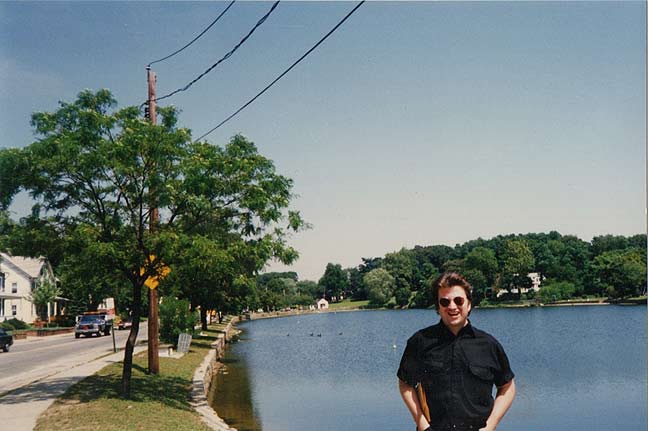
After years of working nights in a variety of nondescript buildings, I enjoyed being able to walk over to Mill Pond, shown above behind me. Port Washington also borders on Manhasset Bay and there is a nearby beach in Manorhaven. This was a novel experience. Three trains from Bay Ridge was a pain, though, and I relocated to Flushing, along the LIRR Port Washington branch, in 1993.
When I went to the PCH studio, an old-school manager, Sam S., was in charge and he had been part of an independent shop that PCH purchased, and he still did mechanicals the old fashioned way, with rapidograph pens, T-squares and paste-ups. I duly toiled away for a few months until he retired and PCH moved to Macs and computer graphics, and I was in business. Shown above are two of my workstations.
In early 2006 I was rehired as a proofreader, but things had rigidified somewhat at PCH and I wasn’t allowed to shift between departments as before. My first stint, however, was a lot of fun for me, as well as the suburban setting.
I’m hearing that PCH will be relocating to Jericho, in the midsection of Long Island, by 2016.

??????, Greenwich and Morton Streets, 5/95
In keeping with my motto of always having two jobs, I was looking around for part time evening work after my job as a a typesetter with the Center for the Media Arts ended. In the spring of 1995, I worked for a few weeks at a firm of which I’ve completely forgotten the name, laying out textbooks in QuarkXPress in this building at Greenwich and Morton Streets, a few blocks away from where ModKomp was, but it didn’t take.
The building appears to be the worse for wear since I was there. This stretch is absolutely uninhabited on Sunday afternoons.
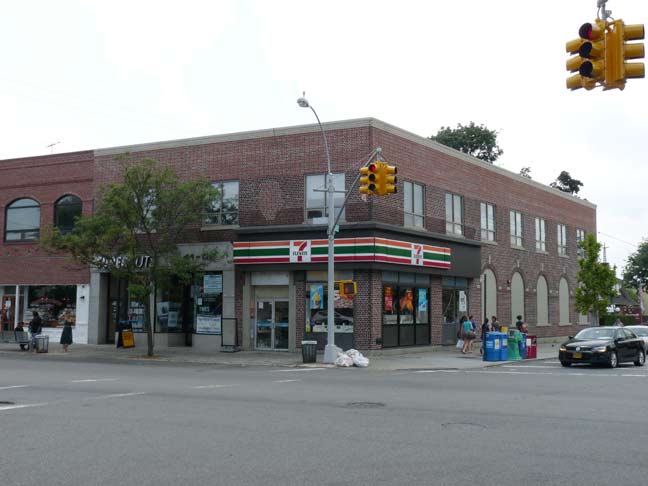
Times-Ledger Newspapers, 41-02 Bell Boulevard, Bayside, 5/96–5/09
Still looking for evening work, I dialed a number in a newspaper (told you it was easy back then) and was hired to do layouts using QuarkXPress and later, InDesign at a chain of local Queens newspapers. This turned out to be my longest stint at any job, anywhere. Roz Liston, the associate editor who hired me, is still there today [2014] as executive editor. I would work from about six to as long as it took to finish all twelve editions, sometimes till 1 AM. Back at nights again!
It was an eminently convenient location as I would get the LIRR from Port Washington and my day job at PCH, get off at Bayside and walk one block to the Times-Ledger, work till late, then back on the LIRR to my home station at Broadway. I had a monthly LIRR ticket, which was cheaper then. I could ride as often as I wished.
I lasted 13 years until two things happened: I needed a heart valve replaced, which would sideline me a couple of months, and Rupert Murdoch’s News Corp. bought the chain, moving the layout operations to Brooklyn. I would have worked in Brooklyn even though I was by then living in Little Neck, but my job wasn’t saved.
Standard Motor Products, 37-18 Northern Boulevard, 11/99
This huge building stretching along Northern Boulevard in Long Island City has railroad sidings in the Sunnyside Yards. SMP was founded in 1919 by Elias Fife and Ralph Van Allen, producing electric parts for the auto industry, then poised to become a major player in the 20th Century. The firm moved to Queens as early as 1921 and bought its present-day behemoth in 1936. SMP has sold the building since, but remains a tenant.
I filled in here for just two weeks after my first layoff from Publishers Clearing House in November 1999, but I’m happy to have been involved with such a longstanding institution.
For the last decade, 37-18 Northern Boulevard has had an added function: commercial farming.

??????, 39 West 14th Street, Union Square area, 12/99
For a few days, I again tried my hand at book composition in a firm in this building near Union Square, but again, it didn’t take.

Marx Myles, 386 Park Avenue South at East 27th Street, Madison Square area, 2/00-3/00
I worked for a few weeks at Marx Myles, a longstanding printing firm that’s still in business a few blocks away on 6th Avenue. I did mostly copy editing and proofreading, a bit of layout. I was offered fulltime, but I got a somewhat better offer from my next location at (what had been) the World’s Biggest Store.
Its high rise building on Park Avenue South (originally 4th Avenue) has Deco touches, which seems to plant it firmly in the 1928-1935 era.

Macy’s, 151 West 34th Street, Herald Square-Penn Station, 4/00–10/04
I’m showing the back end of the Macy’s flagship store on 7th Avenue because this was the view I had each day when emerging from Penn Station, where I took the LIRR from Flushing each day. The employees’ entrance is an obscure doorway next to the deli on the corner of 7th Avenue and West 35th.
Macy’s was founded as a dry goods store in 1858 on 6th Avenue and West 14th Street by Rowland Hussey Macy, a former whaler from Nantucket, MA. He had run several smaller stores in Haverhill, MA before moving to NYC. His tattoo acquired while at sea, a red 5-pointed star, became Macy’s symbol. There are still several red stars visible in the concrete ornamentation of a building on West 13th Street, the back end of the original store. Macy died in 1877. After 40 years on West 18th in the Ladies’ Mile district, Macy’s moved uptown to a new building in Herald Square in 1902.
Macy’s expanded and was able to purchase all the property in the block surrounded by 6th and 7th Avenues and West 34th and 35th Streets, and eventually built new ells and extensions to the original store except for two small plots at Broadway and West 34th and 7th and East 35th. The store leased property on the small corner building on Broadway and has erected a series of giant billboards in the spot.
Macy’s eventually occupied a total of 2.2 million square feet at Herald Square and for many years was billed as “The World’s Biggest Store.” It was, however, dethroned in that department by the South Korean chain Shinsegae, which opened a 3.16 million sq. ft. store in Busan in 2009.
While I worked at Macy’s as a copywriter, I noted its remaining wooden escalators and composed a page honoring them in 2007. Some of the ones on my page, though, may have been modified or replaced since then.
The office where I worked, officially part of Macy’s Advertex division, was on the 17th floor and several of the offices opened up onto a ledge that overlooked 7th Avenue. Naturally, I got out there on a number of occasions and took photos of the view, sticking the camera over the edge. On 9/11/01 I watched scrambling fighter jets from the ledge.
Macy’s was the first job I found through social media, since I answered an ad on a job site, perhaps Monster. FNY was in full swing by the time I was hired and at lunchtime I would wander around the neighborhood or even take the subway up or downtown. I was using a film camera then and got everything developed in a small shop on 7th Avenue.
After a “departmental organization” in late 2004 my goose was again cooked and after looking around for a few months, I was hired at…

Harris Publications, 1115 Broadway at West 25th Street, Madison Square, 8/05–5/06
I was hired as a copy editor, proofreader and general office guy Friday by magazine editor Barbara J. Harris published a variety of home decoration magazines edited by Barbara, who gave me the chance to write a few articles, which I was able to do with the magic of internet reference, since I’m nobody’s home decorator. Harris also published other magazines such as Vibe.
The building is a typical 1920s office building, albeit in the center of the old Toy District, which I’ll return to later. Rubie’s, the world’s largest costumer, occupies the entire 9th floor (the firm originated in 1951 in Richmond Hill, Queens and still owns a large building there.
In the spring of 2006, I worked at Harris on Tuesday and Thursday and at Publishers Clearing House on Monday, Wednesday and Friday until PCH management rehired me full time.
Medallion Retail, 37 West 20th Street, Ladies’ Mile, 11/11–2/12
I worked for three months in this retail signmaker, which had its origins as a type shop in the 1950s. The bulk of the work was creating store signage as well as advertising blurbs for bookseller Barnes & Noble.
37 West 20th is fairly nondescript, but it’s right next door to the old Episcopal Church of the Holy Communion, designed by Richard Upjohn, which was begun in 1844. In the 1980s and 1990s it was the decidedly un-holy Limelight, but in 2014 it has become a women’s furnishings retail store, with a side order of Grimaldi’s Pizza.
Tiffany & Co., 200 5th Avenue, Madison Square, 4/13, 8/13– )
I don’t own a single item of jewelry, but have worked several months as a freelance proofreader/copy editor (and making several brilliant saves) at the world’s biggest jeweler, working on their website which is published in several different languages, all of which, it seems, have different ways of punctuation and different copyright marks, etc. which I was brought in to check, as well as their customer emails, which also differ by country.
Tiffany’s flagship store is uptown on 5th Avenue and 57th Street, but their main offices relocated in 2011 to 200 5th Avenue, originally the Fifth Avenue Building when built in 1912 (its original clock still stands). The building, formerly the International Toy Center, had been home to offices in that industry; it is now occupied by Tiffany and the Grey Group (formerly Grey Advertsing). Eataly, the famed aggregation of Italian restaurants, occupies the ground floor along with an ever-shifting array of retail establishments.
Walking the floor at Tiffany, I noticed several of the steel columns bearing the name Carnegie. Two titans of capitalism right there, Louis Comfort Tiffany and Andrew Carnegie.
Where’s my next stop? Something soon, I hope…
8/17/14












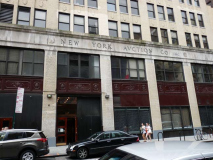
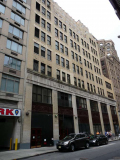
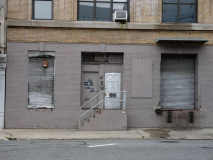







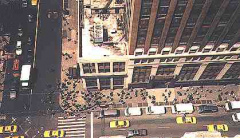




25 comments
Sorry, can’t help but I’m a former PCH worker as well, 1978-80 (way before your time). Was a beautiful office in a great area.
It’s as if you have worked all over NYC for this kind of resume.
You’ve got the wrong building identified as 387 Park Avenue South. Here’s a link to the actual 387: http://www.rew-online.com/wp-content/uploads/2014/05/387Pas.jpg
You’re right, my building was 386. Fixed.
IIRC, 386 was used by Baruch College during the 70’s. They had one or two floors in the middle of the building, and then the top 3 or 4 floors. The PAS entrance was for the school only. The street-side entrance was used for the commercial tenants.
I worked for EMI music at 150 5th Ave for 10 years, from 2003-2013. EMI had purchased the building and moved people in from various other offices around town. Universal bought them out in late 2012 and as of now the company maintains 1 or 2 floors in the building and leases out the rest. Some of us lucky enough to survive the takeover are at the main Unversal HQ in a non descript building on B’way in the 50’s.
For the last few years I was there, 150 had a life size cut out of the Beatles in the main vestibule which tourists would stop and photograph. Perhaps it is still there.
If I ever hear of anything here, I’ll let you know. You certainly have been around.
I took the Daily News tour in 1970.The linotype guys would give you a free sample of your name in linotype lead but ya had to use the right kind of ink to print your name withit so I chucked it.
Kevin, with that amount of moves you should have been in the Navy. Over a twenty year career I served on six ships, a couple of shore tours, more schools than I care to count, a couple of exchange tours on foreign ships and all in different locations. One of which was Coastal Drydock in the former Brooklyn Navy Yard. Our common theme song would be “I Get Around”.
My father worked at Stuyvesant Town for 30 years. I’d rather not move around that much but they keep laying me off. I’ve been good but never indispensible.
Glad to see that 1115 wasn’t the worst dump that you worked in. Photo-Lettering may win for flaking plaster and mold.
For anyone thinking of hiring Kevin, my recommendation is, DO IT. He’s intelligent AND industrious and will pick up whatever you throw at him.
Well, 1115 Bway does have a nice lobby
There’s a prejudice concerning hiring people in our age group.
Your office at CMA reminds me of the service bureau I worked at in Portland, OR in 1993-4.
We had two of those CompuGraphic typesetters, one of which had a balky feed mechanism that was a bear to keep running evenly.
These machines needed constant repair and were always leaking fluid that turned into a white powder.
Enjoyed this page quite a lot. Reading your personal work history was an autbiographical account that I found interesting and engaging. I like your writing. It is clear, down to earth, and conversational. Also liked the descriptions of the nuts and bolts of typographical work and proofreading. – Now I see why FNY is so well planned and layed out!!
Also found your histories of these buildings and their neighborhoods, interesting and choc full of details – material for your next awaited book maybe?
Best wishes for your finding employment soonj!
Ed
Happy Birthday Kevin!
Wishing you the BEST!
p.s. Good luck on the job search. Hang in there.
Great article! The personal touch makes it even more interesting- as does the info about the publishing business and the various processes formerly used.
But sheesh- Publisher’s Clearing House? When they hired you, did they send you a letter saying “You may have already been hired…”? (Ed McMahon probably just thought you’d make a good drinking buddy, what with the Irish name and all… :D)
I noticed that we may have crossed paths at some point, I also attended the Germain School of Photography at Center for the Media Arts in 92-93. I grew up in the LES, went to school in Brooklyn, and later Queens. Now relocated, I always love to read about your exploration and history of NYC. Thanks for all your hard work.
Hi, ive been searching for my old school, Center for the Media Arts. I too, alumni, 1987-89. I took the Advertising Art and Design course, along with Photography and more! I loved the school, its training and like yourself, it set the foundation for me to getting work an artist—technical artist, then known as Mechanical Art in advertising, currently evolved to desktop publishing. But, my question is, how do we get in contact with the school to get records. Your help would be greatly appreciated.
Building is still there
I attended Center for the Media Arts from 89 to 91. AND I was the afternoon typesetter for a while. Great to see the picture of the little room. It’s exactly how I remember it!
we were there at the same time, I was there 1990-1993 when it folded
Hi Kevin,
I loved your records and musings. I was a student at Center for Media Arts from about 85-88 taking mechanical designs with a great artist wizened teacher named Mr. Beltran or simply Mr. B. He had designed many Hollywood poster of bygone times and had met Marylyn Monroe and a bunch of other stars from those days and told great stories. I would think he has passed, but I am grateful to him. Thank you again.
Kevin, I worked at Photogenic from summer 1980 through summer 1982. I don’t remember you, but I remember the company and many people who worked there. Still in touch with a few.
I was on the evening shift. There was a fella named Cezario who didn’t like my line breaks and would redo all of them! When I was laid off, they gave me a tip to call Photo-Lettering, and I stayed there for 6 years.